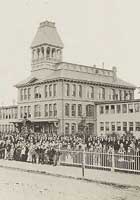Crisis Leadership: Waltham Watch Company, 1837–1957
Financial crises place extraordinary demands on business leaders. Surges in bankruptcy rates testify to the hazards involved, but these brief periods of cataclysm have also been opportunities for firms to change ingrained habits and emerge as industry leaders. One such firm was the renowned Waltham Watch Company, which pioneered the production of watches from interchangeable parts. Like all manufacturers of non-essential products, Waltham leadership faced difficult decisions in times of financial upheaval. “A business so sensitive as ours to the touch of hard times,” wrote then-owner Royal E. Robbins, could not simply hunker down and wait for prosperity to return.18 In 1837, 1857, and 1873, shrewd leaders turned crisis into opportunity.
It was the Panic of 1837 that inspired company founder Aaron Dennison to mechanize the production of watches, a technique recently applied to firearms. Dennison, an artisan watchmaker underemployed throughout the crisis years, calculated that interchangeable parts could dramatically reduce the high labor costs associated with handicrafts manufacture. Dennison spent the recession devising machinery and prototypes for his mill, and when investment funds became available in the late 1840s, he was well positioned to put his inventions to work.19
Dennison’s genius was for innovation, not management, however. When the next crisis hit in 1857, he had too many watch lines in development. The firm went bankrupt, but the new manager-owner, Royal Robbins, embarked on a disciplined new strategy that transformed Dennison’s vision into a profitable company. First, Robbins dedicated the factory to a single product line. Then, instead of curtailing production during the downturn, he kept the mills running full steam and persuaded workers to accept a 50 percent pay cut. Salesmen sold large quantities of watches cheaply, often at auction, to popularize the product with a public accustomed to thinking of watches as expensive luxury items. When prosperity returned, inexpensive Waltham watches had a ready market.20
Waltham watches had saturated the domestic market by the 1870s, so Robbins took advantage of the 1873 downturn to court new customers: women, with their often-overlooked purchasing power, and the market abroad. The firm developed new products and launched a successful advertising campaign that featured a fully mechanized exhibition of Waltham watch production methods that was displayed at international expositions. In 1876, while the rest of the world struggled to emerge from recession, Waltham reached its greatest market dominance.21
- Royal E. Robbins, Treasurer’s Report 1862. Waltham Watch Collection, Box AD-1, Baker Library Historical Collections, Harvard Business School.↖
- Charles M. Walden, Timing a Century: A History of the Waltham Watch Company (Cambridge, MA: Harvard University Press, 1945), pp. 6, 152–154.↖
- Ibid., pp. 29–32, 154–155.↖
- Ibid., p. 55.↖

![Parts of One 16 size Waltham Watch Movement--Actual Size' Waltham Watch Company. The Home of the Waltham Watch. [Waltham, Mass.: Waltham Watch Co., 19--?]. Baker Old Class Collection, Baker Library Historical Collections.](images/fc-137.jpg)
![Waltham Watch Movements, Actual Size. Waltham Watch Company. The Home of the Waltham Watch. [Waltham, Mass.: Waltham Watch Co., 19--?]. Baker Old Class Collection, Baker Library Historical Collections.](images/fc-138.jpg)
![Engraving of Aaron Dennison. E.A. Marsh. The Original American Watch Plant. [Waltham, Mass.] : Waltham Watch Company,1909. Baker Old Class Collection, Baker Library Historical Collections.](images/fc-130.jpg)

